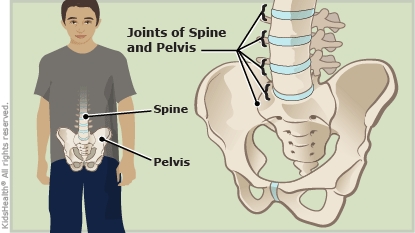Juvenile Ankylosing Spondylitis: How to Care for Your Child
Juvenile ankylosing spondylitis (JAS) is a type of arthritis. It affects the spine (backbone), the pelvis, and large joints of the leg (like the hips). Starting treatment as early as possible can help relieve pain and make other problems less likely. Although there is no cure for JAS, most people who have it can live active, healthy lives.


-
Give your child medicine as prescribed by your health care provider.
-
Moving around can help reduce pain and stiffness. Encourage your child to be active. Try activities that are easy on the joints, such as tai chi, walking or swimming.
-
Keep up with the stretches or exercises (including breathing exercises) recommended by your health care provider.
-
Have your child sleep on his or her back on a firm mattress with a thin pillow or no pillow under the head.
-
Follow directions for keeping good posture. This can help avoid a hunched posture later on.
-
Your child should not smoke and should avoid secondhand smoke.
-
Go to all follow-up appointments as directed. Your child might need to see specialists such as physical therapists, rheumatologists (joint doctors), orthopedists (bone doctors), ophthalmologists (eye doctors), or geneticists (doctors who specialize in conditions that are inherited).
-
Ask your health care provider if it's OK for your child to play contact sports.

Your child:

Your child:
-
has trouble breathing
-
has severe pain in joints, neck or chest
-
develops sudden or severe eye pain, blurry vision or sensitivity to light
-
develops weakness, difficulty urinating (peeing), numbness or tingling

What do the words "juvenile ankylosing spondylitis" mean? The words refer to inflammation (redness, heat, pain or swelling) of the joints in the spine, resulting in a stiff or painful back:
What happens in JAS? When a child has JAS, the joints in the spine, pelvis or legs become inflamed. Damage to these joints can lead to pain in the lower back or large joints of the leg. The bones that make up the spine (vertebrae) may eventually fuse together, causing stiffness in the back.
Some kids with JAS have other problems, including:
-
pain or swelling in other places (like the feet)
-
trouble taking deep breaths
-
a hunched posture that develops over time
-
weight loss or feeling very tired
-
problems with their eyes, heart or lungs
Symptoms might come and go. Some kids might have only mild symptoms, while others might be more severely affected. It is different in every child.
Who gets JAS? It is seen more often in boys and tends to run in families. Symptoms usually begin in the late teens or young adulthood.
How is JAS treated? The goal of treatment is to help your child have as normal and active a lifestyle as possible. The main treatments for JAS are medicines, exercises and physical therapy to help decrease pain and increase flexibility. If someone has severe pain or joint damage, surgery is sometimes recommended.